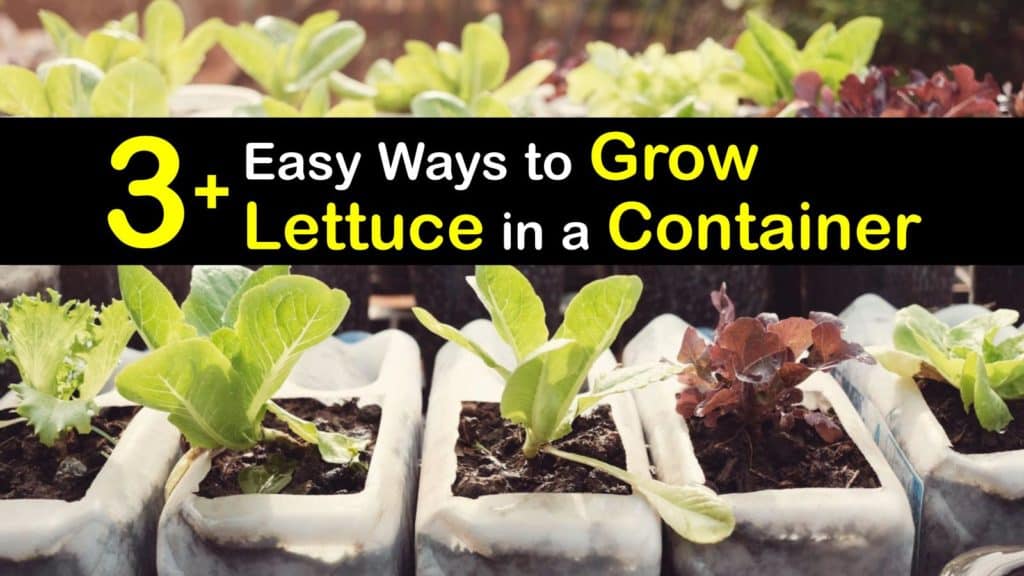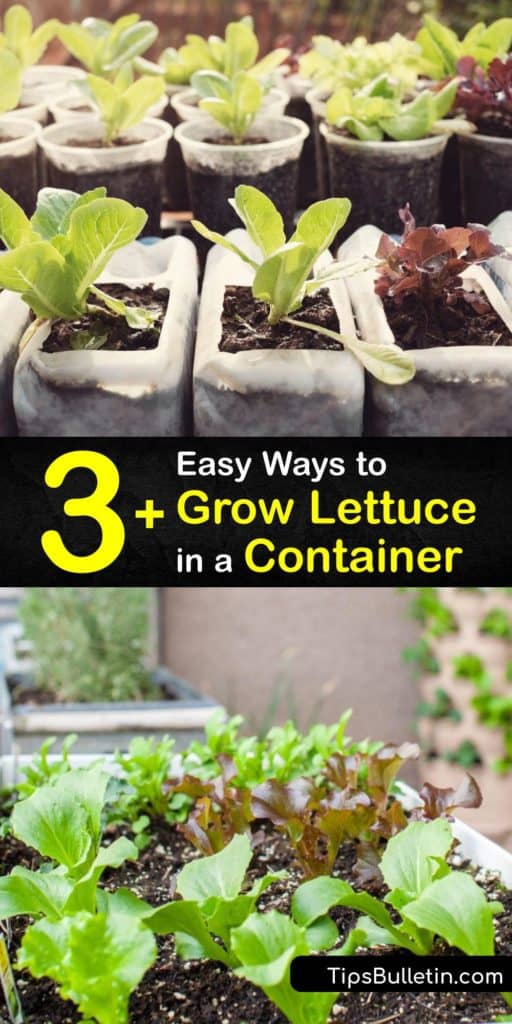Lettuce is so versatile and easy to cultivate, it’s possible to grow it just about anywhere. In this article, learn all about how to grow lettuce in a container so you can enjoy homegrown fresh salad anytime you like.
Growing lettuce in containers is possible both indoors and outdoors. All you need is a pot with several drainage holes at the bottom, nutrient-rich potting soil, and consistent watering.
One of the numerous advantages of container gardening is that you control your plants’ growing conditions. Lettuce is a fast-growing cool-season crop that thrives in mild temperatures between 60-70℉. If possible, give your lettuce plants a bit of shade on warm afternoons.

How to Grow Lettuce in Containers
With so many different varieties to choose from, it’s easy to find the perfect cultivars to suit your growing climate and available small space. Read on to discover the best tips and tricks for planting lettuce in containers.
Growing lettuce in a container is a convenient way to have easy access to fresh salad greens, no matter what different types of leaf lettuce you decide to plant.
Note that it is also possible to grow lettuce in water from scraps. It’s a great way to enjoy fresh organic lettuce year-round.
Certain lettuces have distinctly lobed leaves, earning them the nickname “oakleaf lettuce.” Looseleaf lettuce tends to be the fastest-growing type. It forms a loose head that’s ready to harvest in five or six weeks.
Romaine lettuce grows in a loose head with long, thickly veined leaves. This type of lettuce is popular for making Caesar salad and lettuce wraps. Growing romaine lettuce in pots is just as easy as growing it in the garden or a raised bed.

Butterhead lettuce usually takes the longest to mature, taking eight to nine weeks from planting to harvest. However, it’s more heat-tolerant than other lettuce varieties.
To set yourself up for success, the way to grow lettuce in a pot is to choose pots with several drainage holes at the bottom, so excess water doesn’t stagnate.
Otherwise, your lettuce plants are at a higher risk of root rot and fungal disease. Also, it’s best not to use clay pots, as they absorb water and cause the soil to dry out faster.
Lettuce plants have shallow roots, which makes it possible to grow them in relatively shallow containers, whether you are growing lettuce indoors or have it in a pot on the patio. When you transplant lettuce seedlings or grow lettuce from seeds, use a pot that’s at least six inches deep. Spacing between each plant should be 12-16 inches.
Lettuce thrives in partial shade to full sun. Although lettuce plants survive temperatures as cold as 40℉, they grow much faster between 60-70℉.
For the best possible results, use a well-draining potting mix rich in nutrients and organic matter. Look for a soil mix containing added perlite for drainage and coconut coir or peat moss for moisture retention.
It’s beneficial to fertilize your lettuce plants every three or four weeks throughout the growing season. Use an organic, all-purpose fertilizer with equal amounts of nitrogen (N), phosphorus (P), and potassium (K).
Keep your garden soil moist but not oversaturated. Container-grown lettuce plants require about two inches of water each week. Mulch around the plants to retain moisture, suppress weeds and insulate the soil.
Growing Lettuce in Containers from Seed
When considering how to grow lettuce in containers, many gardeners prefer directly sowing seeds rather than transplanting nursery-grown lettuce seedlings to avoid disturbing their sensitive roots.
When planting vegetables in a container, fill your pot up to an inch below the rim with potting soil. It’s helpful to pre-moisten the dirt to avoid disturbing your seeds after planting them. The optimal soil temperature for germinating lettuce seeds is 55-65℉. Germination takes seven to ten days.
Since lettuce seeds are so tiny, the way to grow iceberg lettuce or another variety is to sow them no more than a quarter-inch deep and top with a thin layer of potting mix.
For a continuous supply of fresh lettuce leaves, try succession planting lettuce seeds in your container garden every two weeks until the weather is consistently hotter than 80℉.
In hot weather, lettuce plants cease leaf production and begin bolting or generating flowers and seeds. The leaves turn bitter and inedible.
When to Plant Lettuce Outdoors
Mature lettuce plants are moderately cold-hardy and can survive a light frost. However, young plants are more sensitive and require protection from early spring freezes.
If you’re sowing lettuce seeds directly in your container, plant seeds around the last frost date for your area. For nursery-grown seedlings, it’s beneficial to harden them off for about a week before transplanting. Leave them out in the elements for progressively longer periods each day.
Plant another round of seeds for a fall lettuce crop as soon as the weather starts cooling off in late summer. In mild climates, it’s possible to grow lettuce in a container garden year-round or try growing lettuce in containers on your kitchen windowsill during colder months.
How to Grow Lettuce in a Container Inside
Nothing beats having easy access to fresh salad greens growing right on your windowsill. Ensure they get at least four to six hours of bright light each day.
Indoor lettuce plants often grow a bit slower. When to harvest lettuce is when the tender leaves are baby greens. As soon as the plant forms a rosette of eight or ten leaves two or three inches long, it’s ready to pick.
Keep picking the outer leaves as needed until just before the plant bolts. At this point, cut the entire plant an inch or two above the soil level. If desired, you can grow a smaller second harvest in a few more weeks.
Store your fresh lettuce in a perforated plastic bag for up to two weeks. Lettuce stays fresh in the crisper drawer of your refrigerator for up to ten days.
Troubleshooting Common Pest and Disease Problems
Although lettuce is generally easy to grow, monitor your plants for signs of pest and disease damage. Healthy plants are much less susceptible to attacks from lettuce bugs and pathogens. Their best defense is to receive adequate amounts of light, nutrients, and water.
Aphids, slugs, and snails are the most commonplace insects that feed on lettuce leaves. Use diatomaceous earth or mulch with eggshells to combat slugs and snails.
Spray the entire plant with an organic insecticide like neem oil or insecticidal soap at the first sign of an aphid infestation.
The most prevalent diseases for lettuce plants include bacterial leaf spot, downy mildew, powdery mildew, and mosaic virus. Treat any affected plants with an organic copper or sulfur fungicide.
Growing lettuce in containers is the perfect solution for growers working in a small space or if you’re out of room in a small garden. If you’re wondering how to grow lettuce in containers, know that it’s a remarkably straightforward DIY project.
All that’s required is a pot with drainage holes at the bottom, nutrient-rich potting soil, and plenty of water and sunshine.

If you enjoyed these container gardening tips, please share this article about how to grow lettuce in a container with your friends and family on Pinterest and Facebook.